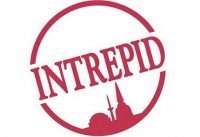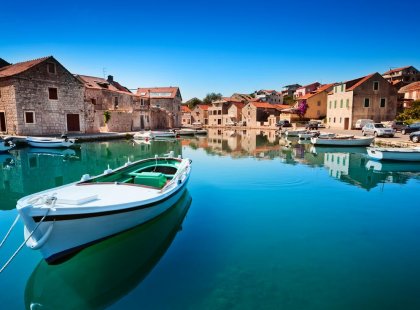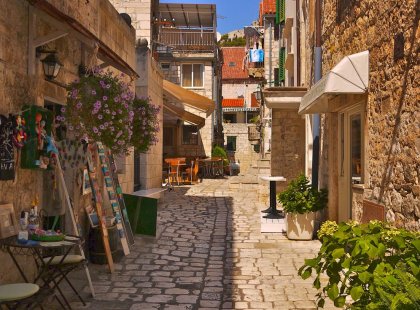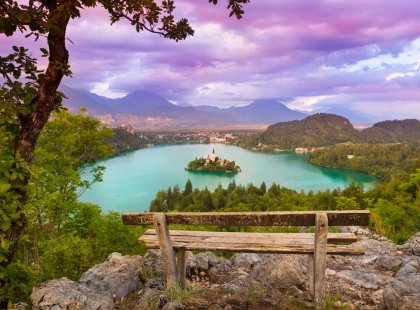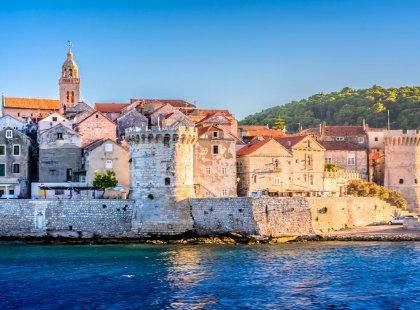Dubrovnik to Bled
15 days
From
$ 3231
Duration15 days
Visit Croatia and Slovenia on a tour from Dubrovnik to Bled. Visit Croatia and Slovenia as you take the scenic route from lively Dubrovnik to pristine Bled. Experience both history and nature at their best - from Roman ruins and walled cities to unspoilt beaches and rugged islands just off the Adriatic coast. Quaff wine with locals in Korcula, delve into the ancient history of Split, hike through the Hvar hinterland and be swept up in the magic of Bled. Discover a wealth of European architecture and lose yourself in the serenity of this charming and picturesque region.
-
Duration: 15 daysService level: Standard
-
Starts in: Hotel DubrovnikPhysical Grading: Light
-
Ages: 15+
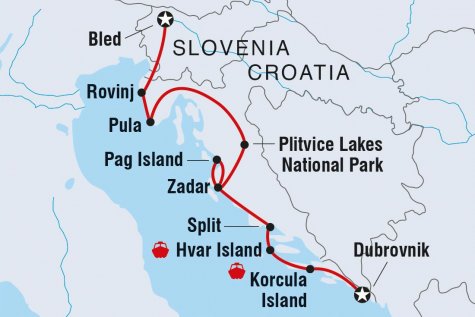
Itinerary
Day 1: Dubrovnik
Start place: Hotel Dubrovnik
Dobro Dosli! Welcome to Croatia. Dubrovnik is a beautiful white stone town whose old town is surrounded entirely by city walls. Although it experienced devastation during the war in the early 1990s, the restored old town remains as charming as ever. With the sparkling water of the Adriatic in the background, Dubrovnik is picturesque, full of character and its old town can easily be covered on foot. If you arrive early, why not head out to one of the Elafiti Islands. There's Lopud, a quiet island with lovely hikes, clean beaches and a ruined castle. Kolocep is a sleepy enclave that boasts walks for every fitness level, and Sipan is the most populated of the isles and reputedly has the most hospitable inhabitants. After the group meeting, perhaps enjoy a meal with the group so you can get to know your fellow travellers.
Day 2: Dubrovnik
Start the day with a walk along the city walls of ‘Game of Thrones’ fame, enjoying views of the sparkling Adriatic Sea in this undisputed jewel of the Dalmatian Coast. The rest of the day is free for you to enjoy all that Dubrovnik has to offer. Visit Big Onofrio's Fountain, built by architect Onofrio della Cava in the 15th century to supply water to the city. Perhaps check out the Franciscan monastery, home to one of the world's oldest pharmacies, or the Sponza and Rector's Palaces, the only Renaissance buildings in the city to survive a devastating earthquake and fire in 1667. You can get a snapshot of Croatian history at one of many museums, take a quiet moment inside an old cathedral, or cruise out to nearby Lokrum Island. If you still feel energetic after a day exploring the city, you can take the switchbacks leading up Srd Hill behind Dubrovnik for spectacular views of the city and the Dalmatian coastline. Alternatively, the newly restored cable car can whisk you to the top in less than 10 minutes. The hill is topped by a castle from Napoleonic times, which now houses the Museum of the Croatian War of Independence.
Meals: B
Day 3: Korcula Island
Journey by bus and boat to Korcula (approximately 4 hours). The time you depart and your travel time may vary depending on the transport schedule. For the next two nights, stay with generous hosts – locals who rent out their rooms in the summer season. The rooms, while simple, are the best way to put money back into the local economy. Later in the afternoon, make the short journey by local bus (approximately 30 minutes) to the tiny village of Pupnat (population: 300) in the interior of the island. Here you’ll visit a local family-owned restaurant and eat outside on the patio. Sample some of the family vineyard's wines and be treated to a meal made entirely from ingredients found on the farm. Perhaps you can drink your wine like the locals do: mixed with a bit of water. The traditional Dalmatian meat loaf, or pasticada, and fresh grilled vegetables with olive oil constitute a typical dish, all served with fresh goat and sheep cheeses, and maybe some smoked ham to tie it all together. Don't forget to have a bit of travarica (a grappa-like drink made with the herb called verbane) and some Korcula cakes for dessert before heading back to Korcula town.
Meals: B, D
Day 4: Korcula Island
Today is a free day for you to take in the serene forest landscape, dotted with tranquil inlets and character-filled vineyards, on an island where natives believe Marco Polo was born. Whether or not this can be proved (the Venetians have a similar claim), Korcula is steeped in a long history and the islanders are proud owners of this little gem, smaller than Dubrovnik but no less precious to its inhabitants. Greeks settled in the 6th century BC (they called the island Black Korcula), but the town was also occupied by the Romans, the Slavs, and then the longest period of rule passed to the Venetians between 1420 and 1797. Even Napoleon was ruler for a while. As a result of all these influences, Korcula has a stunning Old Town – romantic and evocative. And what's more, there are plenty of warm beaches to relax on if that's more your speed. You might like to take a swim, walk around the bays and villages near Korcula town, pay a visit to the Marco Polo Tower, go shopping, or just soak up the ambience. If you're feeling energetic, take a snorkelling or mountain-biking day trip. Your leader can help arrange these activities from your base in Korcula.
Day 5: Hvar Island
A hydrofoil ferry takes you to the neighbouring island of Hvar (approximately 90 minutes). Beautiful Hvar has an air of Venice about it, and is known as the 'Queen of the Dalmatian Islands'. Wander around a town with wonderfully preserved Renaissance facades, hike past dramatic jagged limestone cliffs and slow your pace to enjoy the undulating farms, fields of lavender and rosemary, and ancient olive groves. Upon arrival, get to know the town with an orientation walk and visit the 16th century Spanjola Fortress, from where spectacular views over town and this part of the Adriatic can be had. Feel the history when wandering the backstreets of quirky galleries and unique boutiques, watch the fishermen bring the day’s catch into the quay, and chill out over a few cocktails in a waterside bar.
Day 6: Hvar Island
This morning grab a bus to the interior of the island where your leader will take you on a leisurely hike through the abandoned villages of Velo Grablje and Malo Grablje, gently descending all the way down to the sea at Milna Bay. On the way you will witness what remains of the typical Mediterranean life that flourished on the Croatian islands in the 18th and 19th centuries. Cool down in the turquoise waters upon arrival into the little town of Milna where the hike ends. The rest of the day is free. There are plenty of options for exciting activities in town, or take a short boat ride to the nearby Pakleni islands – largely uninhabited and often described as being among the most beautiful in the world. If you don’t feel energetic today, spend the day lounging at one of the island's many quiet beaches and enjoy a sunset stroll along the harbour promenade. Tonight, be sure to sample the some of the best seafood around, caught fresh that day.
Day 7: Split
Catch a boat to Split (approximately 2 hours). If Dubrovnik is considered the heart of Dalmatia, Split is certainly its soul. Situated on a small peninsula on the eastern shores of the Adriatic Sea, it's the second largest city in Croatia. Join a local guide for a walking tour of this stunning seaside town and get to know its history. See the original and fantastically preserved basements under the city, as well as the Cathedral in Diocletian's Peristyle and Jupiter's Temple. Explore the impressive ruins of Diocletian's Palace, Split's most imposing structure and some of the most interesting ruins on the Adriatic coast. Portions of the Palace are over 1,700 years old and there’s ample time to experience this time-defying structure. Split grew out from Diocletian's Palace and you can almost see it evolving in a multitude of different ways right before your eyes. Some cultures might have made the palace a museum, but Split is a dynamic and vibrant place, and the palace houses many businesses and homes. If your feet get tired, why not grab a drink at a cafe on the Riva Promenade and people watch for a while.
Day 8: Split
Today you'll have more time to explore Split. You might like to take a day trip to the surrounding area and visit the ancient Roman city of Salona, or the sleepy towns of Trogir or Sibenik. In the evening why not head out for some fresh seafood with your travel companions?
Day 9: Zadar
Travel by local bus northwest to Zadar (approximately 3 hours). For centuries Zadar was the capital city of Dalmatia, and the city's rich heritage is visible at every step. An important coastal town, the musical steps of the ‘Sea Organ’ on Zadar's waterfront express its important relationship with the sea. Trace marble streets through the Old Town and discover Roman ruins in amongst medieval churches. Enjoy some local food and drinks in a city that’s home to a vibrant café culture. Zadarsko pivo is a light beer with a very pleasant taste, just a little bit bitter, with a rich flavour. Afterwards, perhaps treat yourself to a gourmet meal at a contemporary Croatian restaurant. Try lamb in red wine, 'njoki' with Dalmatian ham and rocket salad, or opt for the popular choice of fresh fish: tuna carpaccio or a fillet in scampi sauce. Also try the famous liqueur, Maraskino, made from locally-grown maraschino cherries according to a centuries' old secret recipe. This unique drink was a favourite at European imperial and royal courts and has been produced in Zadar since 1821.
Day 10: Pag Island / Zadar
Today embark on a full day trip to Pag Island (approximately 1 hour from Zadar). The karst island of Pag is home to sheep, and a determined group of islanders who wring themselves a living from the barren, rocky landscape. Settled in pre-Roman times, the island has been at the mercy of the shifting fortunes of various Dalmatian rulers, and today reminders of its prosperous salt-mining past are visible around the island. Explore the old town of Pag, or swim in one of the shallow coves near town that make Pag Island a popular destination for beachgoers. Meet a producer of the island's renowned paški sir – Pag cheese. Eaten sliced with black olives or ham, or grated and used instead of Parmesan, paški sir is salty with a sharp tangy flavour. This distinctive cheese comes from Pag Island's sheep, who roam the rocky island eating aromatic herbs and grass on slopes coated in salt deposits by strong sea winds. The milk is collected in May, left unpasteurised during fermentation, then rubbed with sea salt and olive oil and left to age anywhere from six months to a year. Indulge in some of the cheese along with some local wine. This is followed by lunch, which is usually lamb cooked under the bell, with a vegetarian option available also. Once back in Zadar perhaps visit the famous modern ‘Greeting to the Sun’ and the more ancient St. Donat`s Church and St. Anastasia’s Cathedral.
Meals: B, L
Day 11: Plitvice Lakes National Park
Take a drive inland and travel north to your next base of Grabovac (approximately 2 hours). Here you’ll visit Plitvice Lakes National Park, a misty Eden of endless waterfalls and spectral blue lakes. Fed by the Bijela and Crna (White and Black) Rivers, the waters tumble from a high, tree-lined ridge down through the valley and skirt dense forests of beech, spruce and pine. A series of wooden walkways pass over the landscape, ensuring there’s little impact upon the park. 16 stunning turquoise lakes, fed by underground springs, are split into the upper and lower lakes. The upper are in the dolomite cliffs, where rushing water weaves in and out of the karst, dropping dramatically down to the lower lakes, with enchanting forests, grottoes and steep cliffs. This interplay of water, rock, and plant-life creates a wondrous, dynamic landscape, changing the water colour from azure to bright green, deep blue to grey. Look to the canopy for over 120 species of birds, including hawks and owls. The butterflies that hover through the trees transform the park into a riot of colour in the autumn. Even amongst this pristine natural beauty, the Plitvice Lakes are shadowed by the region's history. The 1991 civil war erupted here after rebel Serbs took control of the park's headquarters, holding the park for the duration of the war and devastating infrastructure, though thankfully leaving the natural landscape intact.
Meals: B
Day 12: Pula
Take the drive to Pula, the capital of the province of Istria (approximately 4 hours). A Roman amphitheatre, a wealth of architectural sights and a hedonistic bent make Pula a great place to catch a concert or sample some Istrian cuisine. Pula has a long history as a Roman citadel, a pirate target and a naval port, and today this regional and economic centre is powered by shipbuilding, textiles, metals and glass. On a free day, a wander through Pula's Old Town is like a step back in time to its heyday as a Roman regional administrative centre. Follow the Roman walls and pass through the Triumphal Arch of Sergius from 27 BC. On the pedestrianized streets of the Old Town, see the ancient Forum, whose sole remaining structure is the Temple of Augustus, rebuilt after almost total devastation in World War II. The Roman Amphitheatre is Pula's most impressive sight. Overlooking the harbour, it was built in the 1st century and designed to hold up to 20,000 spectators, who revelled in the bloodthirsty gladiatorial contests shown there. It’s a spectacular sight as the sun sets.
Meals: B
Day 13: Rovinj / Bled
Cross the border into Slovenia and travel into the Julian Alps to Bled (approximately 3.5 hours). En route, stop in the coastal gem of Rovinj, one of the best-kept towns on the Adriatic Coast. There will be time to wander the picturesque streets this morning, taking in colourful buildings and a splendid waterfront with a relaxed Mediterranean feel. Through the centuries, Rovinj’s character has enchanted many an artist or writer, including Jules Verne. Climb the campanile of Sv Euphemia Cathedral in the middle of the old town, or browse the stands of the daily open-air market for truffles, olive oil, seafood or fruit and vegetables. Alternatively, you may just want to find a spot for a cold drink and watch the world go by. After another short drive, arrive in Bled, situated on the stunning lake of the same name. Take in the mountainous backdrop, lake, and impressive cliff-top fortress, which all combine to make this a wonderful place to visit. There are many outdoor activities to get the blood pumping in Bled: rafting, caving, canoeing and swimming, to name a few.
Day 14: Bled
This morning embark on a walk around beautiful Lake Bled with your leader (approx 2 hours). This scenic walk passes some impressive villas, mostly from the beginning of the 19th century, including the residence of the former Yugoslav president 'Marshal' Tito – today the Hotel Vila Bled. The rest of the day is free for you to explore all that Bled and the surrounding area has to offer. If you’re feeling active, consider riding out to Vintgar Gorge (4 kilometres) and walk through the natural canyon. Bled is renowned for its mild, healing climate and thermal lake water. Maybe head to the 100 metre high cliff-top Old Bled Castle, dating from the 11th century and overlooking sparkling Lake Bled, then take a Pletna boat ride (a wooden, awning-covered boat rowed by a special oarsman) to the island on Lake Bled – climb up the 99 steps to St Mary's Church and ring the wishing bell. Be sure to seek out the famous Bled cream cake, which isn’t hard; nearly every cafe and cake shop in town claims that theirs is the best. You might even consider doing a day trip to nearby Ljubljana, Slovenia's compact yet cosmopolitan capital city. Then, why not celebrate the end of a remarkable journey with a final group meal.
Day 15: Bled
There are no activities planned for the final day and you are able to depart the accommodation at any time. As there is so much to see and do in Bled and the surrounding mountains you may want to consider extending your trip and stay longer in Bled. We are able to book additional accommodation for you, subject to availability. Please enquire at the time of booking.
Inclusions
Included
- Dubrovnik - Card (1 day local transport and entry to sites)
- Dubrovnik City Walls Walk
- Korcula - Pupnat Village Dinner
- Hvar - Spanjola Fortress entrance
- Hike from Velo Grablje to Milna Bay
- Split - Guided City Tour
- Diocletian's Palace
- Split Cathedral & Tower
- Visit to Pag Cheese Maker with Cheese Degustation & Lunch
- Day Trip to Pag Island
- Plitvice Lakes National Park
- Pula Arena
- Walk around Lake Bled
-
Transport
Public bus, Private vehicle, Ferry, Taxi -
Accommodation
Hotel (2 nights), Hostel (4 nights), Pension (2 nights), Guesthouse (1 night), Private rooms (5 nights)
